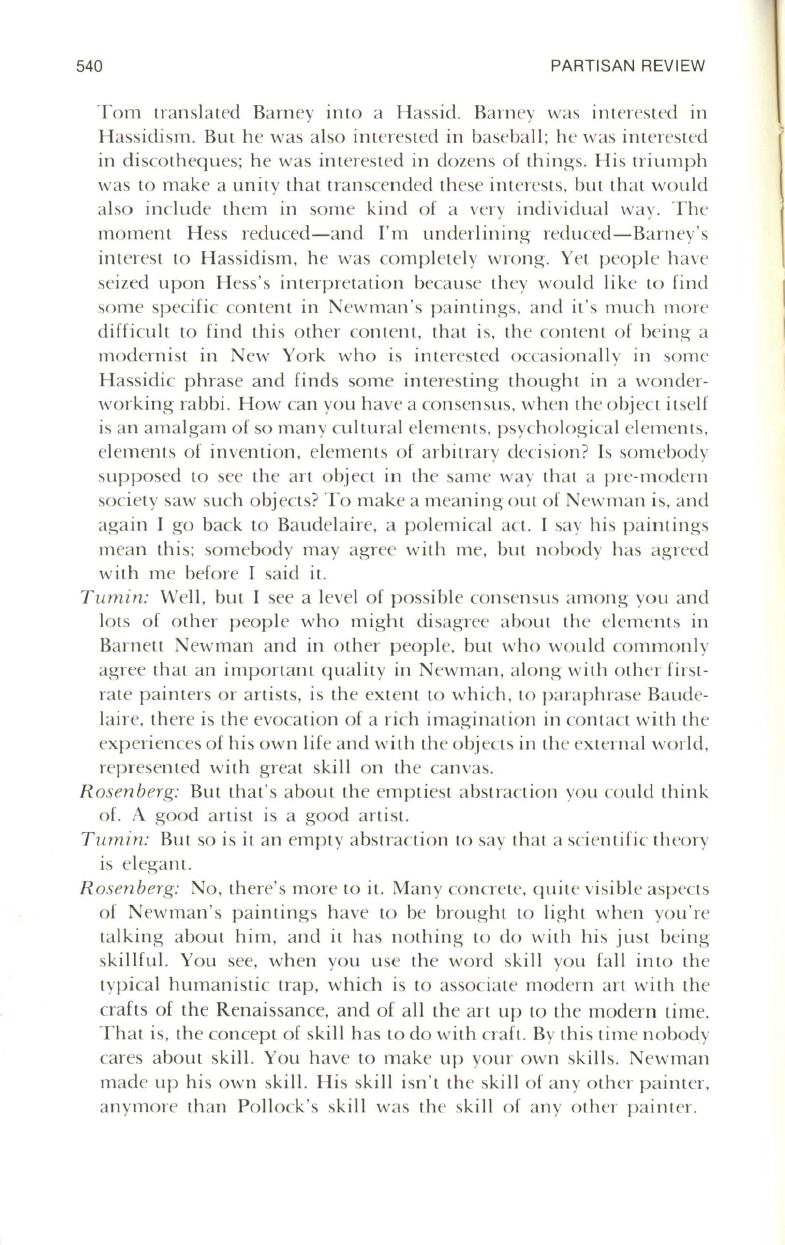
540
PARTISAN REVIEW
T om translated Ba rn ey into a Hass id. Ba rney was inLerested in
Hass idi sm. But he wa s a lso inLcrested in baseba ll; he was int eres ted
in di sco th equ es; he was interes ted in dozens of things. Hi s triumph
was
to
make a unity tha t transcended these inLerests, but that wo uld
also include them in some kind of a very individua l wa y. T he
momenL Hess redu ced -and I'm underlining reduced-Ba rn ey's
interes t
to
Hass idi sm, he wa s compl etely wrong. Yet peopl e ha\'e
seized upon Hess's inLerpretati o n because they wo uld like
to
find
some specifi c COnLent in Newma n 's pa intings, and it's much mo re
difficult to find thi s o ther contenL, th a t is, th e cont ent o f be in g a
moderni st in New Yo rk who is interes ted occasiona ll y in some
H assidic phrase and find s some interestin g thou ght in a wo nder–
wo rkin g rabbi . How can you have a con sensus, when the o bj ec t itse lf
is an ama lgam of so man y cultura l elements, psycho logica l element s,
elements of invenLi on , elemenLs of a rbitra ry dec ision ? Is somebody
supposed to see the art obj ec t in th e same way th a t a pre-modern
society saw such obj ects ? T o make a meanin g out of Newman is, and
aga in I go back to Baudelaire, a pol emi ca l act. I say hi s pa intings
mean this; somebody may agree with me, but nobod y has agreed
with me befo re I sa id it.
T umi n:
Well, but I see a level of poss ibl e consensus among you and
lo ts of o ther peopl e who mi ght di sagree a bout the elements in
Barnell Newman and in o ther p eopl e, but who wo uld commonl y
agree th a t an impon anL qua lity in Newman , a lo ng with o ther first–
ra te pa inLers o r arti sts, is the extent
to
whi ch , to pa raphrase Baude–
la ir e, there is th e evoca ti on of a ri ch imagina ti on in contact with the
experi ences o f hi s own life and with the o bj ects in the extern a l wo rld ,
represented with g rea t skill o n th e canvas.
R osenberg:
But that's about th e empti es t abstraction you could think
o f. A good ani st is a good ani st.
Tumin:
But so is it an empty abstrac ti o n to say tha t a scienLifi c th eory
is elegant.
R osenberg:
No , there's more to it. Many concrete, quite vi sibl e aspects
of Newman 's paintings have to be brought to li ght when you 're
ta lking abo ut him, and it has n o thing
to
do with his just bein g
skillf ul. You see, wh en you use the word ski II you fa ll in
to
the
typi cal humani sti c trap , whi ch is
to
assoc ia te modern an with the
crafts of the Renaissance, and of all the art up to the modern time.
T ha t is, the concept of skill has
to
do with craft. By thi s time nobody
ca res abo ut skill. You have to ma ke up your own skill s. Newman
made up hi s own skill. Hi s skill isn 't the skill of any oth er pa inter,
anymo re than Poll ock' s skill was th e skill o f any o ther painter.


